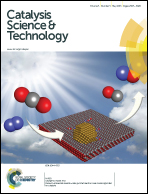Theoretical studies on the mechanism of oxygen reduction reaction on clean and O-substituted Ta3N5(100) surfaces
Abstract
The reaction mechanism of oxygen reduction reaction (ORR) on Ta3N5(100) surfaces was examined theoretically. In particular, the effects of O-substitution on the catalytic activity have been discussed. First, the adsorption energy and geometry of an oxygen molecule adsorbed on a clean and an O-substituted Ta3N5(100) surface were calculated. Energy diagrams for 2-electron and 4-electron reactions on clean and O-substituted Ta3N5(100) surfaces were then examined. The results show that the adsorption energy of an oxygen molecule on the clean Ta3N5(100) surface is almost zero and the oxygen molecule is easier to adsorb on the O-substituted surface. However, OH and H2O adsorb strongly on the O-substituted surfaces so that their desorption can be the rate-determining step. To improve the ORR activity, both O2 and OH adsorption energies should be tuned. By analysis of the energy level of adsorbates and Ta3N5 O-substituted surface, the impurity state of Ta3N5 is found to be the key descriptor for the adsorption energy. Therefore, the ORR activity can be controlled by changing the energy of the impurity state.


 Please wait while we load your content...
Please wait while we load your content...